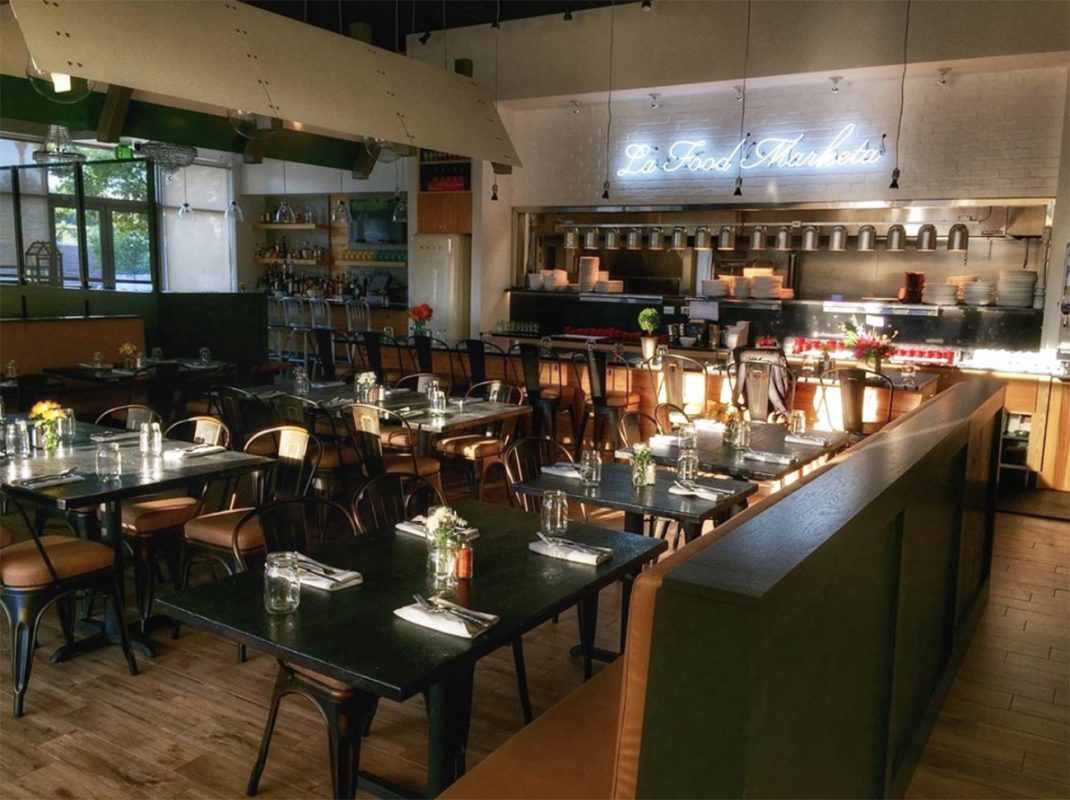
Chef Johntay Bedingfield took first place on Chopped in 2019, but getting creative during the COVID crisis has also put his talents to the test.
“Restaurants will survive this,” Bedingfield says. “You go out to eat because you don’t have time to cook or you just feel like getting pampered. People can let go and enjoy the moment and the company of people they are with. That’s not going to go away.”
Bedingfield, who grew up watching his mother and grandmother cook, has been La Food Marketa’s executive chef since 2016. But he didn’t come to cooking right away. He studied psychology at Wesley College in Delaware and became a substance abuse counselor before becoming a childcare worker for the Board of Child Care in Baltimore for several years.
“I was like, ‘School is over. I’m in my 20s and have to figure out a career move. Maybe I’ll just start cooking,’” he says. “I had always liked cooking. I love comfort food and home-cooked meals.”
He decided to enroll at Baltimore International College for a master’s degree in international hospitality management. “I got a job at Sunday River in the Towson mall. I started as a prep cook. Right away, I was like, ‘I love this.’”
And the rest is Baltimore food history.
What has it been like at La Food Marketa throughout the crisis?
On March 16th, the day we officially went into a state of emergency, I worked that day, but we weren’t open for service that evening. We laid off all hourly employees—that was extremely difficult—but with not being able to open to capacity, we had to pull the trigger. We have dedicated management teams, so we just spilt them up between the La Food Marketa, [Hampden sister-spot] The Food Market, and our catering, and it was divide and conquer. That Tuesday, we tried curbside pickup. It was slow that night, but pretty much every week has been different. We’ve tried to stay up on what others states and countries are doing that are ahead of us. Safety has been our first priority. That first week we set a handwashing timer. It was an hourly timer so we could get into the cycle of washing our hands. It was annoying, but it worked. Now we call it “muscle hour.” Since we have no tables now, everyone stops and does 10 pushups in the middle of the dining room and washes their hands. It breaks up the day and its team building.
How is your patio dining going?
We just got through our first week of patio dining. When it was put into effect, essentially, we had only 24 hours to turn over outdoor procedures by that Friday, but we didn’t think it was the right time. There was too much to get moving and execute safely and correctly, so we waited. I think a first impression makes all the difference. There’s a level of accountability there that’s hard to gain back once you lose it. We waited until last Monday and I think it couldn’t have gone better. We had a great night. We sat 60 people throughout the night outside, and carryout was still popping.
“That first week we set an hourly handwashing timer so we could get into the cycle of washing our hands. It was annoying, but it worked. Now we call it “muscle hour.” Since we have no tables now, everyone stops and does 10 pushups in the middle of the dining room and washes their hands. It breaks up the day and its team building.” —Johntay Bedingfield
What safety systems have you put in place?
We shifted gears and moved our pickup to the back side of the restaurant. We are requesting that guests wear masks to the table for the safety and the staff is wearing masks the whole time. We have QR codes at the table for contactless menus and hand sanitizer at each table. We are just trying to stay as up with the trends as possible.
How does this change things for you as a chef?
I could spend hours and hours overthinking what the future is going to bring, but I’ve learned it doesn’t do anything for me. It’s 100 percent under the control of the government right now. We could have 30 ideas on what the next move is going to be, but what I’ve learned over the past 13 weeks is to just wait for them to give the word and then you react. I’ve always been a fan of “the worst decision is no decision,” so once they pull the trigger, we will react to that.
How is your revenue?
Our overall revenue is down. You have three factors when it comes to revenue. You have rent, which is fixed. But you have two things you can control, labor and food purchasing, so we’ve controlled both of those things.
How do you know how much to order?
It’s extremely difficult. My food costs have been at 26 percent each week. The goal is 30 percent to make a 10 percent profit. You get what you need to get in the beginning of the week, and then you have to anticipate what you’re going to need for the weekend and keep spending as tight as possible.
Have you had to change the menu?
As a dish comes to me, I just throw it on the menu and see if we can sell it. One thing that has helped a lot is cross utilization of a product, so you’ll see ground turkey across a few dishes. We have it in our house-made turkey chorizo, or you can add it to queso, or get Turkey chorizo tacos, or get a ground turkey taco salad. So you know that you will always be moving the product, which definitely helps. Other than that, it’s all about seasonal for me—cooking with what the farmers have. I recently got these fresh soft shells from J.J. McDonnell and made soft-shell arepas.
Are you finding that diners are more appreciative now?
The diners have absolutely been extremely grateful. They thank us for being here. That makes our job less stressful to know that the community has us and we’ve made the right move by being there for them.
I know that a lot of chefs have had more time to cook at home. Have you?
The restaurant is closed earlier and opening at noon. I’ve had some more time in the morning cooking breakfast, which is really nice.
Do you think fewer people will want to go into hospitality now that they see how hard a business it is?
I joked with my wife, Alexa, that everyone, including all of those people making their sourdough, is a home cook right now. I’d love some of these people to take their passion and come to the restaurant kitchen. I feel like a lot of people have found the simplicity in life. The hustle and bustle have slowed down a little bit. I don’t know what that will do for the restaurant industry if people are cooking at home more, but there will always be a place for restaurants—no question.
“I joked with my wife, Alexa, that everyone, including all of those people making their sourdough, is a home cook right now. I’d love some of these people to take their passion and come to the restaurant kitchen.” —Johntay Bedingfield
I know that Hoopla Hospitality, which includes La Food Marketa, The Food Market, Quality Snowballs, and Hoopla Catering is very community-minded. Have you done anything in the wake of the recent protests for racial justice?
Last Wednesday, we sold gift certificates and 50 percent of gift card sales went to the NAACP.
On a personal note, you recently lost 50 pounds. Can you tell us about it?
I saw myself on Chopped and didn’t like the way I looked. I had a complete lifestyle change.
I just switched my mind to think of what I enjoyed eating. It was easy as a chef to just throw something in the fryer—it cooks super fast and a few minutes later it’s ready to eat. But I told myself that I get the best fruits and vegetables and meat. We work with these local farmers, and the beauty of being in the restaurant is that everything is already set up—your lettuces and tomatoes and cukes are already cut. I just changed my eating habits.
I have this thing that I call, “walking the line.” I start on the cold side and I’ll grab a bowl and start with a base of vegetables, which is going to be lettuce, tomato, and cucumber. Then I walk over to the sauté station and add some onion. And then I throw turkey chorizo on there and add pico de gallo and guacamole. And it’s a one-minute meal. I’ve had this mental switch. I live for a really good salad now.
